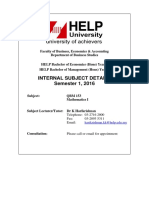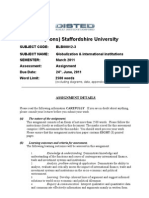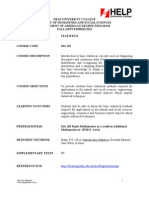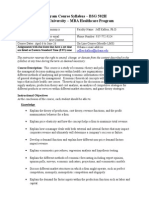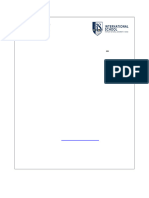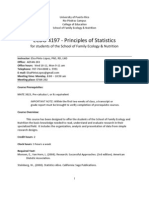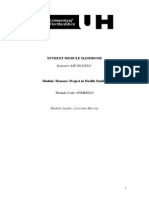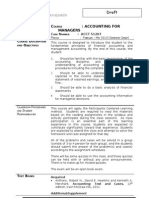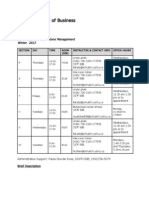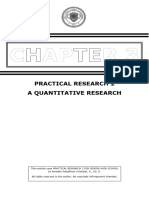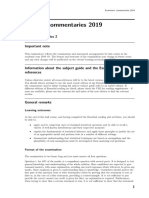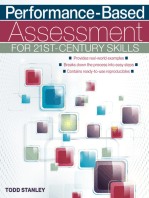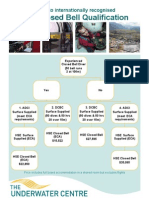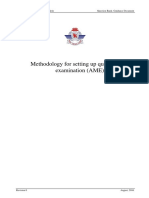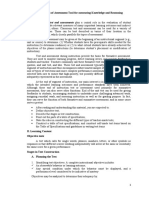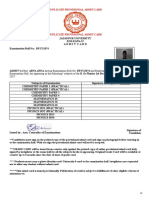QBM101
QBM101
Uploaded by
Shang BinCopyright:
Available Formats
QBM101
QBM101
Uploaded by
Shang BinCopyright
Available Formats
Share this document
Did you find this document useful?
Is this content inappropriate?
Copyright:
Available Formats
QBM101
QBM101
Uploaded by
Shang BinCopyright:
Available Formats
Faculty of Business, Economics & Accounting Department of Business Studies HELP Bachelor of Business (HONS) Year 1 - HUBBU
INTERNAL SUBJECT DETAILS Semester 2, 2011
Subject: QBM 101 Business Statistics Mr. Yap Fu Chu Telephone: 03-2096 1511 Fax: 03-2095 7063 Email: yapfc@help.ed.my
Subject Lecturer/: Tutor
Tutor:
Mr Thayaparan Telephone: 012-6981174 Email: thayaparan_sabapathy@yahoo.com Ms Jessy Lee Sho Ying Telephone: 03- 2095 8791 Email: jesseylee_sy@yahoo.com
Tutor:
Consultation:
By appointment
PRE-REQUISITE(S) No pre-requisite is required.
SYNOPSIS Students will be introduced to the concepts involved in descriptive and inferential statistics. Topics include the role of statistics in a scientific investigation, methods of condensing, displaying, describing and presenting data, elementary descriptive statistics, elementary probability, binomial, Poisson and normal distributions, single-sample inference, comparison of frequencies, regression and correlation.
LEARNING OUTCOME Upon completion of this subject, students should be able to: recognise the need for statistics and the steps involved in sound scientific procedure for experiments and investigations in their discipline; use statistics correctly in helping the results of their experiments and investigations to withstand critical evaluation;
use appropriate pictorial representations and displays to help in interpretation and presentation of data; calculate and interpret measures of central tendency and dispersion, and use the appropriate measure in a given situation; compute probabilities for mutually exclusive events, dependent and independent events and apply these techniques to commonly-occurring situations; describe and be able to apply the properties of the binomial, poisson and normal distributions in the appropriate circumstances; make statistical inferences based on a single random sample;
evaluate and correctly interpret the correlation between two variables, and fit a line of regression to a set of bivariate data and correctly interpret and use this line.
TOPICS Topic 1 Topic 2 Topic 3 Topic 4 Topic 5 Topic 6 Topic 7 Topic 8 Topic 9 Topic 10 Topic 11 What is Statistics? Frequency distribution and graphic presentation. Measures of location. Measures of dispersion and skewness. Probability concepts and principles of counting. Discrete probability distributions. The normal probability distribution. Sampling distributions. Estimation and sample size determination Testing of hypothesis: Describing a single population Linear regression and correlation.
COMPUTER PACKAGE Interpretation of Outputs from the Microsoft Excel will be tested both in the midsemester test and the final examination.
PRESCRIBED TEXT Selvanathan, A., Selvanathan, S., Keller, G. & Warrack, B. (2007) Australian Business Statistics, 4th edition, Thomson
RECOMMENDED REFEFRENCES Keller, G. (2005) Statistics for Management & Economics, 7th edition, Nelson Thomson Learning Weiers R.M.(2005) Introduction to Business Statistics, Fifth Edition, Thomson
Subject Outline / Teaching Plan Department : Business Studies Lecturer : Mr Yap Fu Chu Week 1 2 3 4 5 6 7 8 9 10 11 12 13 14 15 16/17 Topics What is Statistics? Frequency distribution and graphic presentation. Measures of location. Measures of dispersion. Probability : Concept and approach Discrete probability distribution Normal Distribution. Mid Semester Test Week Sampling distributions Estimation and sample size determination Testing of hypothesis. Linear regression and correlation Linear regression and correlation. BREAK Linear regression & correlation/Revision Final examination Business Statistics, 4th Edition Selvanathan, A., Selvanathan, S., Keller, G. & Warrack, B. Thomson 2007 Chapter 21 Subject Code : QBM101 Subject Title : Business Statistics References Chapter 1 Chapters 2 & 3 Chapter 4 Chapter 4 Chapter 5 Chapter 7 Chapter 8
Chapter 10 Chapter 11 Chapter 13 Chapter 21 Chapter 21
Textbook: By: Publisher: Year:
ASSESSMENT There are 3 assessment items for this subject.
Assessment Items
Value
Due Date
To be advised To be advised To be advised (Examination Period)
1. Mid Term Test (Open Book) 2. Quiz (Open book) 3. Final exam (Open Book)
20% 20% 60%
** Subject to change REQUIREMENTS To gain a pass in this subject, students must: Achieve a passing grade in the final examination i.e. score a minimum of 30 marks out of 60 if there is an examination for this subject. Attempt ALL areas of assessment; and achieve a total result of 50% or better overall.
** - Please check on the notice board and My Acel for the actual date. HELP University College reserves the right to make any changes to the above where appropriate.
Department of Business Studies
ACADEMIC INTEGRITY Honesty and Responsibility Academic integrity is an important tenet for HELP University College. In pursuit of the highest standards of academic integrity, the Department of Business Studies holds it students to the highest ethical standards defined by the Rules and Regulations section of the Academic Handbook. All students at the Department of Business Studies are subjected to and are bound by the Student Academic Misconduct Rule to assure academic honesty. Students are required to sign a pledge on the assignment cover sheet before submitting your assignments to the Department of Business Studies. What is Plagiarism? Plagiarism is academic dishonesty or academic theft, and it is a serious academic offence. Plagiarism includes, but is not limited to, the followings: 1. quote, paraphrase or summarize someone elses ideas, theories or data, in whole or in part, without appropriate acknowledgement 2. borrow ideas, opinion or words, in whole or in part, from other sources without properly crediting the author(s) 3. use any facts, statistics, diagrams or graphs, in whole or in part, without acknowledging the source clearly 4. claim or imply original authorship of someone elses ideas, theories or data, in whole or in part, as your own 5. employ or allow someone to help to revise, amend or write your work and pass off as your own original work 6. collaborate with or allow other students to copy your work 7. draw on sources more than what you have acknowledged by citations While a student is not discouraged to discuss an assignment with his/her friends or classmates, the work he/she submits must be done by the student alone. If a student shares his/her assignment with other students and they plagiarize it, the student is as guilty as those students who plagiarized his/her assignment. All parties to plagiarism are considered equally guilty. Under no circumstances should a student be involved in collusion with other students unless he/she is permitted to work on an assignment jointly by the lecturer/tutor. If a student is unsure what constitutes plagiarism, he/she is obliged to consult the lecturer/tutor on the matter before submission of his/her assignment. When and How to Reference? Knowing when and how to cite is a students responsibility. If he/she is in doubt or need more help on this matter, the student may consult the lecturer/tutor. The following list comprises some of the sources a student will need to reference. The list is by no means exhaustive, but simply consists of the most common sources used by students to complete their work. 1. Books 2. Chapters in books
3. 4. 5. 6. 7. 8.
Journal articles Conference papers Newspaper articles Magazines Websites Study guide
Students are advised to cite in the following cases [1]: 1. When he/she quotes two or more words verbatim, or even one word if it is used in a way that is unique to the source 2. When he/she introduce facts that he/she have found in a source 3. When he/she paraphrase or summarize ideas, interpretations, or conclusions that he/she find in a source 4. When he/she introduce information that is not common knowledge or that may be considered common knowledge in your field, but the reader may not know it 5. When he/she borrow the plan or structure of a larger section of a sources argument (for example, using a theory from a source and analyzing the same three case studies that the source uses) 6. When he/she build on anothers method found either in a source or from collaborative work in a lab 7. When he/she build on anothers program in writing computer code or on a notcommonly-known algorithm 8. When he/she collaborate with others in producing knowledge In general, a referencing system requires two parts: 1. In-text citations This is information about a source within the text of an assignment. 2. List of references This is a list of all sources a student has used to research his/her assignment. It is alphabetically arranged by author surname and appears immediately after the last page of an assignment. Different faculties or departments may have different requirement on how referencing for an assignment should be done. The various formats used for in-text citations and list of references are available in the following websites: 1. Harvard System (http://www.adelaide.edu.au/library/guide/gen/harvard.html) 2. Chicago Style (http://www.chicagomanualofstyle.org/index.html) 3. American Psychological Association or APA Style (http://www.apastyle.org) 4. Modern Language Association of America or MLA Style (http://www.mla.org) Once a student has selected a referencing style for his/her assignment, he/she must follow the same style consistently throughout the assignment. We strongly suggest that the student consults the lecturer/tutor about which method to use before submission of his/her assignment.
http://www.yale.edu/bass/writing/sources/plagiarism/warning.html, accessed May 18, 2008.
What are the Procedures and Penalties for Plagiarism?
When a lecturer/tutor encounters a possible case of plagiarism, the lecturer/tutor shall report the matter to the Head of the Department, who then initiates an investigation on the matter. The following procedures would be carried out: 1. The lecturer/tutor shall provide evidence that substantiates an academic offence has occurred. The following documentations must be ready prior to reporting of alleged plagiarism: a. Copy of the alleged plagiarized assignment b. Copy of the source material (e.g. articles, websites, newspaper, etc.) c. Report of plagiarism d. Any other information that would support the claim of plagiarism 2. If the evidence warrants an accusation of academic offence, the Head of Department shall establish a Board of Inquiry comprising 3 academic staff. The Department shall provide all necessary documentations, including report on prior academic offences if applicable, to the Board of Inquiry. 3. The Board of Inquiry shall put the matter to the student in writing and give him/her an opportunity to respond to the accusation within 3 working days. 4. The student will be required to attend a meeting with the Board of Inquiry. After meeting the student, the Board of Inquiry shall decide whether or not the alleged plagiarism has occurred. The following documentations shall be submitted to the Head of Department at the end of the meeting: a. Findings of the investigation b. Recommended action(s) to be taken or imposed 5. The Head of Department shall review the Board of Inquirys report with supporting evidence and shall decide on an appropriate action(s) based on the recommendation of the Board of Inquiry. 6. The decision of the Head of Department shall be put in writing to the student. Copies of all documentations will be retained in the Department. 7. If the student feels that he/she has been unfairly accused or treated, the student may appeal to the Head of Department within 5 working days. 8. The Head of Department shall review the appeal and the final decision will be communicated to the student in writing and a copy will be kept with the Department. Once a determination of plagiarism and penalty has been made by the Head of Department, the investigative process will be deemed to have ended and the student will not be allowed to appeal. Possible penalties for plagiarism range from mark reduction for the assignment to expulsion from the University. The student will not be allowed to make up the assignment. If plagiarism has been found to have occurred, the Department will take action(s) as determined by the forms of plagiarism implicated: 1. Complete plagiarism Verbatim copying another persons work without acknowledgement 1st offence : A grade of F in the subject and a warning letter will be issued 2nd offence : Expulsion from the University at the discretion of the Head of Department
2. Substantial plagiarism Near-verbatim copying another persons work by simply altering the order of the sentences or the format of presentation or by changing a few words or phrases without acknowledgement. 1st offence : Zero mark on the assignment and a warning letter will be issued 2nd offence : A grade of F in the subject and a warning letter will be issued 3rd offence : Expulsion from the University at the discretion of the Head of Department 3. Minimal plagiarism Acknowledgement is made but paraphrasing by changing and/or eliminating some words 1st offence : Deduction of 50% of available marks on the assignment and a warning letter will be issued 2nd offence : A grade of F in the subject and a warning letter will be issued 3rd offence : Expulsion from the University at the discretion of the Head of Department 4. Unintentional plagiarism Insufficient acknowledgement by not applying citation or quotation marks correctly 1st offence : Deduction of up to 50% of available marks on the assignment and a warning letter will be issued nd 2 offence : A grade of F in the subject and a warning letter will be issued 3rd offence : Expulsion from the University at the discretion of the Head of Department Pleading ignorance or unintentional plagiarism does not constitute valid reasons for plagiarism and will not avoid the penalties from being imposed. Excuses for acts of plagiarism such as the following, but not limited to, will not be entertained: 1. I dont have time to do the assignment 2. I have too many assignments due on the same day 3. I dont know, I really didnt do it 4. I am not aware 5. I dont understand what plagiarism means 6. I have no intention to plagiarize 7. I forgot to cite the reference 8. I forgot to include the bibliography 9. My English is not good 10. My lecturer/tutor did not explain to me 11. In my country, it is alright to copy someone elses work 12. My friend copied my assignment when I let him/her to look at my assignment 13. My friend copied my assignment when I allow him/her to use my laptop 14. I did my assignment in the computer lab, someone must have copied my work 15. I asked my friend to submit my assignment and he/she copied my work 16. I discussed my assignment with my friends, so our answers are the same/similar 17. Even though I do not have in-text citation but I have bibliography/reference list Students should be reminded that it is their responsibilities to take due care throughout their written work to effectively reference or cite when they use others ideas from any source.
Faculty of Business, Economics and Accounting
Department of Business Studies
HELP Bachelor of Business (HONS) Year 1
QBM 101 BUSINESS STATISTICS TUTORIAL QUESTIONS Semester 2, 2011 Lecture : Mr. Yap Fu Chu
Tutorial Questions For module 1( Chapters 1, 2, 3 and 4): Question 1 Determine whether each statement is True or False. (1) (2) (3) (4) (5) The height of President Lincoln is an example of a variable. The highest level of measurement is the interval level. The variable of age is an example of a qualitative variable. The weight of pumpkins is considered to be a continuous variable. The boundary of a value such as 6 inches would be 5.9 inches to 6.1 inches.
Select the best answer (6) The number of absences per year a worker has is an example of what type of data? A. B. C. D. Nominal Qualitative Discrete Continuous
(7) Data that can be classified according to colour are measured on what scale? A. B. C. D. Nominal Ratio Ordinal Interval
(8) Use the best answer to complete the following statements (a) Two major branches of statistics are _________________ and ______________ (b) The group of all subjects under study is called a _______________
(c) A group of subjects selected from the group of all subjects under study is called a ________________ (9) For each statement, decide whether descriptive or inferential statistics is used (a) A recent study showed that eating garlic can lower blood pressure. (b) The average number of students in a class at white Oak University is 22.6 (c) It is predicted that the average number of automobiles each household owns will increase next year (d) Last years total attendance at Long Run High Schools football games was 8235 (e) The chance that a person will be robbed in a certain city is 15%
(10) (a) (b) (c) (d) (e)
Classify each as nominal, ordinal, interval, or ratio level
Number of exams given in a statistics course. Rating of word-processing programs as user friendly. Temperatures of a sample of automobile tires test at 55 miles per hour for six minutes Weights of suitcases on a selected commercial airline flight Classification of students according to major field Classify each variable as discrete or continuous.
(11) (a) (b) (c) (d) (e) (f)
The time it takes to drive to work. The number of credit cards a person has The number of employees working in a large department store. The amount of a drug injected into a rat. The amount of sodium contained in a bag of potato chips. The number of cars stolen each week in a large city
Question 2 A variable may be a qualitative variable (being measured on a nominal or ordinal scale), or a quantitative variable (being measured on a ratio or interval scale). Determine whether the following variables are qualitative or quantitative. (a) BRAND OF TOOTHPASTE purchased by customer (b) AGE (in complete years) of respondent. (c) EDUCATION (in complete years of schooling) of applicant (d) POLITICAL AFFILIATION of voter (e) MONTHLY SALARY of wage earner with domain: high, medium, low. (f) DAILY OUTPUT (in physical unit) of employee. (g) ANNUAL PROFIT (in monetary term) of firm (h) QUALITY of product with domain: 1, 2, 3, where 1 = high, 2 = medium, 3 = low. (i) TEST MARK obtained by student in a particular examination paper. (j) POSITION of student in a class of 50 with domain: 1, 2, 3,, 50. Question 3 An insurance company researcher conducted a survey on the number of car thefts in a large city for a period of 30 days last summer. The raw data are shown below. Number of car thefts 55 60 52 70 47 32 44 52 34 36 32 32 40 32 50 63 50 26 40 53 29 44 32 61 34 28 40 38 31 38
(a) Draw an ordered stem and leaf display to sort the number of car thefts. (b) Construct a box-plot for the number of car thefts. Are there any outliers evident from the boxplot? If yes, identify these outliers. (c) Using the Descriptive Statistics function in the Data Analysis tools, generate the table of Summary Statistics for the number of car thefts. Round all statistics with multiple decimal points to one decimal point. (d) Construct a frequency distribution and histogram with equal class intervals for the no. of car thefts. (Ensure the histogram has no gaps, the midpoints are plotted along the xaxis and the graph is appropriately labelled.) Use Both the traditional method and EXCEL method (e) Using the summary statistics, identify the three measures of central tendency and interpret the meaning of each one of these measures for the number of car thefts. (f) Are the data for the number of car thefts skewed? If so, in which direction? Give four reasons to justify this from the outputs generated. (g) What percentages of the car thefts are actually within the two standard deviation of the mean? (h) Stating the rule used, what percentages of the car thefts are expected to be within the two standard deviation of the mean? (i) Does your answer found in (h) agree with or contradict the answer found in (g)? Explain. Question 4 The duration (in minutes) of a sample of a 30 long - distance telephone calls placed by a firm in KL in a given week are recorded in the table below: 11.8 3.6 16.6 13.5 4.8 8.3 8.9 9.1 7.7 2.3 12.1 6.1 10.2 8.1 11.4 6.8 9.6 19.5 15.3 12.3 8.5 15.9 18.7 11.7 6.2 11.2 10.4 7.2 5.5 14.5 (a) Group the data into 6 classes and prepare a frequency distribution of telephone call duration. Use >2 up to and including 5 as the first class and a common class interval. Draw a histogram of the data from the frequency distribution prepared in (a). (Use the graph sheet) With reference to the histogram constructed in (b) above, do the telephone call durations appear to be normally distributed? Explain.
(b)
(c)
(d) (e) (f) (g)
Use the statistics functions on your calculator to find the sample mean and standard deviation of the telephone call duration. Use the range approximation of s to check the value of the standard deviation of the telephone-call duration. Calculate the interval ( x 2s, x 2s ) . What percentage of values would you expect to find outside this interval? Why? What percentage of measurements actually fall outside this interval? Compare this result with your answer in part (f) above.
Question 5 A transport company providing delivery services is analyzing the distribution of the weight of packages delivered. The following are the weights in kilograms of a random sample of 26 packages. 59 67 59 44 54 55 57 79 63 49 100 65 50 62 62 55 54 57 46 60 85 51 48 73 52 54
MS-EXCEL was used to analyze the data. The summary output and box plot follows weight Mean 60 Standard Error 2.47635 Median 57 Mode 54 Standard Deviation 12.63 Sample Variance 159.44 Kurtosis 3.16 Skewness Range 56 Minimum 44 Maximum 100 Sum 1560 Count 26
BoxPlot showing the distribution of package weights
44
54
64
74 Weight in Kg
84
94
104
(a) Identify the three measures of central location and explain the meaning of each one of the three measures. (b) Construct an ordered stem-and-leaf plot to sort the data. (c) Identify any outliers evident from the box plot. (d) The value for skewness in the summary output is missing. Should this value be positive or negative? Justify this by providing one reason from the summary output and one reason from the box-plot. (e) If the outliers are removed, which of the measures of central location would change. Find the new value of any measures which have changed. (f) Calculate the value of the coefficient of variation for the 26 packages. Question 6 The following data represent a sample of 20 problems reported to two different offices of a telephone company and the time to clear these problems (in minutes) from the customers line. Central Office I Time to Clear Problems (minutes) 5.62 5.29 16.25 10.92 11.46 21.62 8.45 8.58 5.41 11.42 11.62 7.29 7.50 7.96 4.42 10.50 7.58 9.29 7.54 8.92 Central Office II Time to Clear Problems (minutes) 9.54 11.46 16.62 12.62 25.75 15.41 14.29 13.13 13.71 10.04 5.75 12.46 9.17 13.21 6.00 2.33 14.25 5.37 6.25 9.71
For central office II, (a) Compute the (i) (ii) (iii) (iv) (v) arithmetic mean and standard deviation median first quartile third quartile coefficient of variation
(b) Construct a box and whisker plot for central office II. The EXCEL numerical descriptive statistics, five figure summary and boxplot for central office I are shown below. Summary statistics showing the time to clear the problems of central office I Mean 9.382 Standard Error 0.893902 Median 8.515 Mode #N/A Standard Deviation 3.997653 Sample Variance 15.98123 Kurtosis 3.848392 Skewness 1.694951 Range 17.2 Minimum 4.42 Maximum 21.62 Sum 187.64 Count 20 Time Smallest = 4.42 Q1 = 7.3425 Median = 8.515 Q3 = 11.295 Largest = 21.62 IQR = 3.9525 Outliers: 21.62,
BoxPlot showing the time to clear the problems of central office I
4.42
6.42
8.42
10.42
12.42
14.42
16.42
18.42
20.42
22.42
Time in minutes
(c) (d) (e)
Are the data for central office I skewed? If so, in which direction? Provide two reasons from the information provided, for your answer in part (c). Identify two obvious differences in the distribution of the times to clear problems between the two central offices?
Question 7 The following are marks obtained by 8 students in an examination. 37 23 18 40 13 35 27 31
(a) Find the mean, median and mode (b) Determine the range and standard deviation (assuming the data is a population) (c) What will be the standard deviation if the data is a sample? (d) Check your above answers by using the SD mode of calculator Question 8 Find the mean and standard deviation for the following frequency distribution of profits(RM Million) of 30 firms(Show full workings). a. b. c. Assuming that it is a population Assuming that it is a sample Use the SD mode of the calculator to check your answers to (i) and (ii) Profits (RM Million) > 9 and up to 11 >11 and up to 13 >13 and up to 15 >15 and up to 17 >17 and up to 19 Number of Firms 3 7 9 6 5
Question 9 The mean and standard deviation of marks of the sample of Statistics and Economics students are shown below: Mean Marks Standard deviation Statistics 80 32 Economics 60 6
Compare the performances of the two groups of students in terms of average performances and dispersion.. Tutorial Questions For Module 2(Chapters 5, 7 and 8) Chapter 5 (1) A hospital administrator is looking over the Medical Society Survey of its members, which records their gender and age. The following table summaries the results. Under 35 Male Female Total 27 14 41 Between 35 & 54 87 25 112 26 3 29 Over 54 140 42 182 Total
If you randomly select a member of the society, what is the probability they are: (a) Male? (b) Between the ages of 35 and 54? (c) Both female and over 54? (d) Both male and between the ages of 35 and 54? (e) Either Male or between the ages of 35 and 54? (f) Either female or over 54? (g) Male, given that they are under 35? (h) Male, given that they are over 54? (i) Over 54, given that they are male? (j) Over 54, given that they are female? (k) Are the events male and between the ages of 35 and 54 independent? (l) Are the events female and over 54 independent? (m) Are the events male and over 54 mutually exclusive? (n) Are the events female and male mutually exclusive?
(2) If P (A) = 0.4, P (B) = 0.5, P (A | B) = 0.6, find P (A U B) (3) A bag contains 8 white balls and 3 black balls. Two balls are drawn, one after the other. Find the probability of drawing one white and one black ball, in any order. (You are advised to draw tree diagrams.) (a) (b) If the first ball is replaced. If the first ball is not replaced.
(4) The probability that the KLCI will rise given that the economic growth is high medium low is 0.5 , 0.3 and 0.10 respectively. Past records indicated that the country had experienced 30% high, 60% medium and 10% low economic growth. (a) (b) What is the probability that the KLCI will rise? What is the probability that the economic growth is low given that the KLCI has just gone up? Chapter 7 (1) Find the mean and standard deviation of the following distributions. (a) XI p(Xi) (b) XI p(XI) -1 0.3 0 0.1 1 0.3 2 0.3 2 0.25 3 0.5 8 0.25
(2) The probability distribution of the number of customers per day at the Sunrise Coffee Shop is shown below. No. of customers (x) Probability (x) 50 0.10 51 0.20 52 0.37 53 0.21 54 0.12 (a) What is the probability that the number of customers per day at the Sunrise Coffee Shop exceeds 53? (b) What is the probability that the number of customers per day at the Sunrise Coffee Shop is more than 50 but less than 54 (c) Find the mean and variance of the number of customers.
(3) The projected profit of a company under three economic condition with the probability of each event happening are given below:
State of Economy Probability Projected Profit (RM000)
Good (G) 0.5 500
Normal (N) 0.3 200
Recession (R) 0.2 300
Find the Expected profit and the value of standard deviation.
(4) The probability of getting a baby boy is 0.5. In 1000 families of five children how many of the family will have: (a) exactly 2 boys? (b) not more than 2 boys (c) less than 2 boys (d) at least 2 boys (e) more than 2 boys (f) Three or less girls?
(5) The warranty records show that the probability that a new car needs a warranty repair in the first 90 days is 0.05. If a sample of ten new cars is selected, (a) what is the probability that in the first 90 days, exactly two need a warranty repair? (b) what is the probability that in the first 90 days more than three need a warranty repair? (c) what are the mean and the standard deviation number of cars? (6) It is claimed that 40 percent of the students were always late for classes. What is the probability that in a sample of 20 students that (a) exactly 5 will be late for classes? (b) less than 5 will be late for classes? (c) at most 5 will be late for classes? (d) at least 5 will be late for classes? (e) more than 5 will be late for classes? (f) more than 3 but less than 8 will be late for classes? (g) Compute mean and variance of the above distribution
(7) A tele-marketeer makes five phone calls per hour and is able to make a sale on 30 percent of these contacts. i. During the next two hours, find: (a) The probability of making exactly 4 sales. (b) The probability of making no sales. (c) The probability of making at least 2 sales. ii. During the next hour, find (a) The probability of making exactly 4 sales. (b) The probability of making no sales. (c) The probability of making at least 2 sales. (8) Suppose that the number of cars sent for repair by a taxi service company is adequately modeled by a Poisson random variable where, on average, 2.5 cars per day are sent for repairs. (a) What is the probability that 4 cars are sent for repairs on a particular day? (b) What is the probability that 2 or more cars are sent for repairs on a particular day? (c) What is the probability that less than 3 cars are sent for repairs in the next 2 days? (9) The number of customers arriving at a vegetable shop between 1 p.m. and 3 p.m. follows a Poisson distribution with a mean of 14 customers. (10) (a) Find the probability that the number of customers arriving between 1 p.m. and 3p.m. is at least 8. (b) Find the probability that exactly one customer arrives between 2p.m.and 3p.m.
(11)
A study of the lines at the checkout registers of safe way supermarket revealed
that, during a certain period at the rush hour, the number of customers waiting averaged two per hour. What is the probability that during that period for two hours?
(a) No customers were waiting. (b) Four customers were waiting. (c) Four or Fewer customers were waiting. (d) Four or more customers were waiting.
(12)
Suppose 300 misprints are distributed randomly throughout a book of 200 pages. Find the probability that a given page contains (a) (b) (c) (d) (e) 2 misprint 2 or more misprints 2 or less misprints less than 2 misprints more than 2 but less than 6 misprints
Chapter 8 (1) The time required to assemble an electronic component is normally distributed, with a mean of 12 minutes and a standard deviation of 1.5 minutes. Find the probability that a particular assembly takes: (a) (b) (c) (d) (e) More than 14 minutes. More than 8 minutes. Less than 14 minutes. Less than 10 minutes. Between 10 and 15 minutes.
(2) Assuming that the weights of chocolate bars manufactured by a company are normally distributed with mean weights of 500 gms and a standard deviation of 5 gms. The company gives a guarantee that any chocolate bar weighing less than 490 gms will be replaced free. (a) (b) What is the probability that a chocolate will have to be replaced? For every 10,000 bars sold how many bars of chocolate are expected to be replaced? (c) If the company wants to make sure that not more than 1% of the chocolate bars are to be replaced, what must be the guaranteed minimum weight of the chocolate bars? (3) The average time a subscriber spends reading The Star newspaper is 49 minutes. Assume the standard deviation is 16 minutes and that the times are normally distributed. (a) What is the probability a randomly selected subscriber will spend at least 1 hour reading the newspaper? (b) For the 10% of subscribers who spend the most time reading the newspaper, how much time do they spend?
(4) Assuming that the monthly wages of workers in that electronic industry are normally distributed with a mean of $3,000 and a standard deviation of $300. i. What is the probability that a randomly selected workers monthly wage a. exceed $3,450 b. is between $3,150 and $3,300 c. is between $2700 and $3600 d. is less than $3,300 ii. What is the minimum monthly wage of the highest 10% of the wage earners? iii. What is the maximum month wage of the lowest 5% of the wage earners? Tutorial Questions For Module 3 - Chapter 10, 11 and 13: Chapter 10 (1) The mean and standard deviation of the marks obtained by the students of Business atatistics is 60 and 20 respectively. If samples of 50 students are
selected at random. What is the probability that the mean weight of the sample of students. (a) Is between 56 and 73 marks? (b) Is between 62 and 68 marks? (c) Is more than 55 marks? (d) Is less than 48 marks?
(2)
Assuming that the weights of people are normally distributed with mean of 70 kg. and standard deviation of 9 kg. A lift is designed to sustain a maximum load of 1500 kg. What is the probability that the lift will be overloaded if there are twenty people in the lift?
(3)
(a) Is it appropriate to use CLT for the following question? If so, find the mean and standard error? (b) The balances of all savings accounts at a local bank have a distribution that is skewed to the right, with the mean of $12,450 and a standard deviation of $4300.Find the probability that the mean balance of a sample of 50 savings accounts selected from this bank will be
j. ii.
more than $11,500 between $12000 and $13800
iii. within $1500 of the population mean.
Q4)
In a shopping complex the mean daily sales of 100 shops was $10,000 with a standard deviation of $500. If a random sample of 30 shops are selected what is the probability that the sample mean is (i) (ii) (iii) more than $10,100? between $9900 and $10,150? less than $10,050?
Q5)
In a certain city, 20% of the residents are smokers. If random samples of 200 residents are selected,
(i) Find the mean and standard error of the resultant sampling distribution of sample proportion. (ii) What is the probability that the sample of resident selected will have a) b) c) more than 18% smokers? between 17% and 21% smokers? less than 16% smokers?
Tutorial Question - Chapter 11:
1. A sample of 50 electric bulbs produced by a company showed that the mean lifetime is 2,000 hours with a population standard deviation of 200 hours. (i) Estimate:
(b) 90% confidence interval for the true mean lifetime of bulbs manufactured by the company. (c) 95% confidence interval for the true mean lifetime of bulbs manufactured by the company. (ii) What must be the minimum sample size so that the sampling error in part (ii) do not exceed 40 hours?
2. In order to estimate the mean time of reporting late to work in a large organization, a random sample of 10 employees selected at random indicated that they are late by the times (in minutes) shown below: 10, 12, 14, 15, 13, 12, 16, 20, 13, 15
Find the 95% and 99% confidence interval for the true population mean time of reporting late to work. 3. A sample of 50 tyres manufactured by a company showed the mean lifetime is 50,000 km with a standard deviation of 500 km. Estimate the confidence interval for the true mean lifetime of tyres manufactured. 95%
4. In order to estimate the proportion of smokers in a certain city, a sample of 100 residents selected at random showed that 30 are smokers. Find the
90% confidence interval for the true proportion of smokers in the city.
5. A university dean wishes to estimate the average number of hours freshmen study each week. The standard deviation from a previous study is 2.6hours.How large a sample must be selected if he wants to be 99% confident of finding whether the true mean differs from the sample mean by 0.5hours. 6. A researcher wishes to estimate within $300 the true average amount of a country spends on road repairs on each year. If she wants to be 90% confident, how large a sample is necessary? The standard deviation is known to be $900. 7. A nutritionist wishes to determine, within3%, the true proportion of adults who do not eat any lunch. If he wishes to be 95% confident that his estimate contains the population proportion, how large a sample will be necessary? A previous study found that 15% of the 125 people surveyed did not eat lunch.
8. A firms management is contemplating modifying one of its products. To help in making the decision, management representatives plan to conduct a market survey that will enable them to estimate the proportion of potential customers who would buy the new modified product. From a random sample of 100 customers selected, 40 indicated that they would buy the new modified product.
(a)
Estimate the 95% confidence interval for the true proportion of all customers who would buy the new modified product.
(b)
Using the given sample proportion, find the minimum sample size required to determine the true proportion, to within 5 %, of all customers who would buy the new product with 95 % confidence.
9. A market analyst in Sydney wants to estimate the proportion of shoppers who will buy a new type of liquid detergent. How large a sample should he take in order to estimate that proportion to within 0.04, with 90% confidence?
10. A manufacturer of a brand of designer jeans realizes that many retailers charge less than the suggested retail price of $40. A random sample of 20 retailers reveals that the mean and the standard deviation of the prices of the jeans are $32 and $2.50 respectively. Estimate with 90% confidence the mean retail price of the jeans.
Tutorial Questions - Chapter 13: 1. The mean weight of students in a college is 50 kg with a standard deviation of 10 kg. It is claimed that the mean weight of the students will be less after the examination. To test the claim a sample of 50 students selected at random after the exam showed a mean weight of 48 kg. Can we accept the claim at the 5% level of significance?
2. The average driving speed for a particular section of the road is supposed to be 100km/hr with the standard deviation of 23km/hr. A sample of 150 cars were found to have an average speed of 93.8km/hr. Is the average speed of cars different from 100km/hr? Use p- value method and 0.05 level of significance.
3. The proportion of smokers in a certain city is used to be 40%. The Government introduces an anti smoking campaign recently. After a few months of introducing the campaign a sample of 100 residents selected showed that 37 are smokers. Do you think that the anti smoking campaign is effective in reducing the proportion of smokers at the 0.05 level of significance?
4. It was reported that in 1988, the fast food industry accounted for more than 61 billion dollars in sales in the world. At this time, McDonalds had captured 18.7% of the market share. Suppose that a random sample of 250 individuals taken recently indicates that 44 preferred McDonalds to all other fast food establishments. At the 0.05 level of significance, is there evidence that the proportion has decreased from the 1988 market share? Use p- value method.
5. The mean diameters of bearings produced by a company are 100 mm. It was claimed that the mean diameters produced have changed. To test the claim a sample of 20 bearings selected at random showed a mean diameters of 105 mm with a standard deviation of 10 mm. Can you accept the claim at the 0.01 level of significance?
6. A courier service in KL advertises that its average delivery time is less than six hours for local deliveries. A random sample of 10 local delivery times follows.
Delivery Time (hours) 7 3 4 6 10 5 6 4 3 8
(a) Is there sufficient evidence to support the claim made by the courier services advertisement at the 5 % level of significance? (b) Explain any assumption made in part (a).
7. The manufacturer of a certain brand of car batteries claims that the mean life of these batteries is 45 months with a standard deviation of 4.5 months. A consumer protection agency that wants to check this claim took a random sample of 36 such batteries and found the mean life for this sample to be 43.75 months with the standard deviation of 4.25 months. (a) Is there evidence at the 0.05 level of significance that the average life of this brand of battery is less than 45 months? (b) Use the p-value of the test to determine whether the conclusion would change if we tested this hypothesis as 0.01 level of significance? Tutorial Questions For Module 4 (Chapter 21) Question 1 A used car dealer was analyzing the relationship between used car prices and age of the cars(in Years) so that he can build a model to predict car prices based on the age of the car. The age and selling price of the 8 cars were recorded and shown below: Age of car (Years) 1 2 3 4 5 6 7 8 a. b. Price($000) 90 85 80 70 55 35 25 18
Calculate SSx , SSy and SSxy Calculate the regression coefficients and hence write down the regression equation and interpret the meaning of the slope coefficient.
c. d.
Calculate the coefficient of determination and explain what does it measures. Calculate the standard error of estimates indicating the units of measurement and what does it measures.
Question 2 A simple linear regression analysis of the relationship between the sales ($ millions) and advertising expenditure ($ thousands) of a random sample of 30 firms was performed using MS EXCEL. The raw data, output and charts for this analysis are given below.
Advertising($thousand 130 125 120 110 115 102 106 100 105 90 80 80 85 87 92 B 95 93 85 85 70 85 68 60 54 50 46 D 42 38 Summary Output Regression Statistics Multiple R 0.93323 R Square 0.87092 Adjusted R Square 0.86631 Standard Error 1.22902 Observations 30 ANOVA Regression Residual Total Df 1 28 29
Sales($million) 11 10 10.5 10 9.2 9.5 9.8 9 A 5 2 4 6 4 7 6 7 5 5 4 3 C 2.5 2.2 2 1.5 2 1 0.5 0.7
SS 285.3606 42.2940 327.6546
MS 285.360 1.5105
F 188.918
Significance F 5.68E-14
Intercept Advertising($000)
Coefficients Standard Error -4.9913 0.78489 0.1227 0.0089
T Stat -6.359 13.744
P-value 7E-07 05.68E-14
Lower 95% -6.599 0.10439
Upper 95% -3.3835 0.14096
Scatterplot of advertising vs sales
12 10 8 6 4 2 0 25 45 65 85 105 125 145 Advertising ($thousands)
Sales ($millions)
Histogram of residuals
8
Frequency
6 4 2 0
-2.5 -1.5 -0.5 0.5 residuals 1.5 More
Residual Plot
4 2 0 -2 0 -4
Residuals
20
40
60
80
100
120
140
Advertising($thousand)
(a)
Identify the independent variable and the dependent variable and interpret the scatter plot.
(b) (c) (d) (e)
Write down the regression equation. Interpret the regression coefficients. What is the value of the coefficient of determination? Interpret its meaning. One of the assumptions of regression analysis is that the error variable is normally distributed. From the information given do you think that this assumption has been violated? Explain.
(f) (g) (h)
Does it appear that heteroscedasticity is a problem here? Explain Estimate the sales for a firm with advertising expenses of $90,000. At the 5% significance level, is there evidence of a relationship between sales and advertising expenditure?
(i)
Estimate with 95% confidence, the slope of the regression line.
RESIDUAL OUTPUT Observation 1 2 3 4 5 6 7 8 9 10 11 12 13 14 15 16 17 18 19 20 21 22 23 24 25 26 27 28 29 30 (j) Predicted Sales($million) 10.9573049 10.34389693 E 8.503673022 9.117080992 7.522220269 8.012946645 7.276857081 7.890265051 6.05004114 G 4.823225198 5.436633169 5.681996357 I 6.05004114 6.66344911 6.418085922 5.436633169 5.436633169 3.596409257 5.436633169 3.351046069 2.369593316 1.633503752 1.142777375 0.652050999 -0.084038566 0.161324623 -0.329401754 Residuals 0.042695096 -0.343896933 0.769511037 1.496326978 0.082919008 F 1.787053355 1.723142919 0.109734949 -1.05004114 H -0.823225198 0.563366831 -1.681996357 0.704595672 -0.05004114 0.33655089 -1.418085922 -0.436633169 -1.436633169 -0.596409257 -2.436633169 -0.851046069 -0.169593316 0.366496248 0.357222625 1.347949001 1.084038566 0.338675377 1.029401754
Find the missing values as indicated by the letters A, B, C, D, E, F, G, H and I.
Question 3 A researcher desires to know whether the typing speed of a secretary (in words per minute) is related to the time (in hours) that it takes the secretary to learn to use a newprocessing program. The data follow. Speed (X) 48 74 52 79 83 56 85 63 88 74 90 92 Time (Y) 7 4 8 3.5 2 6 2.3 5 2.1 4.5 1.9 1.5
A simple linear regression analysis of the relationship between speed (X) and time (Y) was performed. The computer output and scatterplot are presented below. However, because of a printer malfunction, some of the results are not shown. These are indicated by the letters a to h.
Scatterplot of time vs. speed
10
Time(Hrs.)
8 6 4 2 0 45 55 65 75 85 95 Speed(words per minute)
SUMMARY OUTPUT Regression Statistics Multiple R R Square Adjusted R Square Standard Error Observations
* 0.94898473 0.943883204 * A
ANOVA Regression Residual Total Df 1 B 11 Coefficients Intercept Speed, X 14.08565217 -0.13713555 SS 49.02138789 2.635278772 51.65666667 Standard Error 0.755377484 0.010054733 MS 49.02139 C F D Significance F 8.69049E-08
t Stat E -13.6389
P-value 4.25E-09 8.69E-08
RESIDUAL OUTPUT Observation 1 2 3 4 5 6 7 8 9 10 11 12 Predicted Time,Y 7.50314578 3.937621483 6.954603581 3.251943734 2.703401535 6.406061381 2.429130435 5.446112532 2.017723785 G 1.743452685 1.469181586 Residuals -0.50314578 0.062378517 1.045396419 0.248056266 -0.70340153 -0.40606138 -0.12913043 -0.44611253 0.082276215 H 0.156547315 0.030818414
a) Find the missing values A, B, C, D, and E. b) Write down the equation of the fitted line. c) Do the regression coefficients have a sensible interpretation? Interpret these where possible. d) What is the value of standard error and interpret it. e) What are the values of G and H stated in the residual output? f) Find the value of correlation. g) Test whether there is a significant linear relationship between time and typing speed, using the 5 % level of significance.
Question 4 A company issuing credit cards is interested in examining the relationship between annual income and annual expenditure on a credit card. A random sample of 20 credit card users was selected and the annual income (ranging from $20,000 to $120,000) against the annual expenditure (ranging from $1,800 to $11,500) on the credit cards was recorded. The regression of annual expenditure (y), on annual income (x), was completed in Excel. The summary output and graphs follow. Note that annual expenditure is in $ and annual income is in $000. SUMMARY OUTPUT
Regression Statistics Multiple R R Square Adjusted R Square Standard Error Observations 0.99830886 * 0.996432834 176.2644833 20
ANOVA Df Regression Residual Total 1 18 19 SS 164926250 559245.03 165485495 MS 164926250 31069.17 F 5308.357 Significance F 1.06786E-23
Coefficients Intercept Annual Income($000) 31.52419885
Standard Error 99.406357
t Stat 0.317125 72.85848
P-value 0.754798 1.07E-23
98.1398642) 1.3469931
Scatterplot of income vs expenditure
Annual expenditure ($)
14000 12000 10000 8000 6000 4000 2000 0 0 20 40 60 80 100 120 140 Annual income ($'000)
Residual Plot 300 200 100 0 -100 0 -200 -300 -400
Residuals
20
40
60
80
100
120
140
Annual Income ($'000s)
Histogram of residuals
6
Frequency
5 4 3 2 1 0
-300 -200 -100 0 100 200 300
Use the summary output and graphs produced in Excel to answer the following questions. a) How many credit card users were sampled? b) Interpret the scatterplot. c) Write down the equation of the fitted line. d) Interpret the regression coefficients. e) What is the value of the coefficient of determination? With reference to this value, does it appear that annual income is useful for predicting annual expenditure paid by credit card? f) One of the assumptions of regression analysis is that the error variable be normally distributed. Which graph would be used to check this assumption? Is there reason to believe that this assumption has been violated here? Explain. g) Test whether there is any significant linear relationship between annual income and annual expenditure using credit cards
You might also like
- TN3 Assessment To The TeacherDocument5 pagesTN3 Assessment To The TeacherBe Haj100% (1)
- 7002 Course Syllabus Bashaw R 13Document6 pages7002 Course Syllabus Bashaw R 13api-229988011No ratings yet
- ITMD510 Syllabus FA 16Document8 pagesITMD510 Syllabus FA 16Kedar NaikNo ratings yet
- Acknowledgement Receipt For On Line Admission (Stream I)Document2 pagesAcknowledgement Receipt For On Line Admission (Stream I)Dildar Khan BhatiNo ratings yet
- QBM 101 S1 2016Document12 pagesQBM 101 S1 2016herueux100% (1)
- QBM 153 S1 2016Document15 pagesQBM 153 S1 2016herueuxNo ratings yet
- B.A. (Hons) Staffordshire UniversityDocument9 pagesB.A. (Hons) Staffordshire UniversityshinimikageNo ratings yet
- MA 125 Statistics 1 Fall (September) 2011Document9 pagesMA 125 Statistics 1 Fall (September) 2011Kar ChunNo ratings yet
- Guidelines in Writing Chapters 4 & 5Document1 pageGuidelines in Writing Chapters 4 & 5Josua GarciaNo ratings yet
- Scoring of Essay Type QuestionsDocument29 pagesScoring of Essay Type QuestionsSameena MagrayNo ratings yet
- Course SyllabusDocument11 pagesCourse SyllabusShirkeIncNo ratings yet
- MKT205 - Group Assignment - Sept 2024Document9 pagesMKT205 - Group Assignment - Sept 2024Thu Trang NguyễnNo ratings yet
- Chapter OneDocument10 pagesChapter OneFikru TesefayeNo ratings yet
- Statistics and Operations Management IDocument5 pagesStatistics and Operations Management IMike PeñaNo ratings yet
- APC309 Assignment With Grid April 2014 TNE PDFDocument5 pagesAPC309 Assignment With Grid April 2014 TNE PDFTít Thò Lò0% (1)
- CIOPDocument12 pagesCIOPCindy TananisNo ratings yet
- SyllabusDocument13 pagesSyllabusasdfNo ratings yet
- Syllabus ECDO 4197 - Principles of StatisticsDocument8 pagesSyllabus ECDO 4197 - Principles of StatisticsOEAENo ratings yet
- 6NMH0225 Handbook 2012-2013Document21 pages6NMH0225 Handbook 2012-2013shayziaNo ratings yet
- Strategic AccountingDocument4 pagesStrategic AccountingTanim XubayerNo ratings yet
- Examiners' Commentaries 2018: ST104b Statistics 2Document19 pagesExaminers' Commentaries 2018: ST104b Statistics 2Xinjie LinNo ratings yet
- Syllabus 543Document4 pagesSyllabus 543Venkatesh KaulgudNo ratings yet
- OUTLINE Statistics in EducationDocument5 pagesOUTLINE Statistics in EducationAshiq ShahzadNo ratings yet
- Syllabus - Math For Business - BBus - Nguyen Thi Thu Van PDFDocument7 pagesSyllabus - Math For Business - BBus - Nguyen Thi Thu Van PDFMai TrầnNo ratings yet
- Notes - Sample of Guiding Questions To Help YouDocument8 pagesNotes - Sample of Guiding Questions To Help YouCintahatiku SelamanyaNo ratings yet
- GED Past Papers Series No3Document19 pagesGED Past Papers Series No3shashideshpande100% (1)
- ECON 330-Econometrics-Dr. Farooq NaseerDocument5 pagesECON 330-Econometrics-Dr. Farooq NaseerWahaj KamranNo ratings yet
- Akuntansi Untuk Manajer (Feb-Mei 2013)Document5 pagesAkuntansi Untuk Manajer (Feb-Mei 2013)aaabc5816No ratings yet
- APC309 Assignment April 2009Document4 pagesAPC309 Assignment April 2009Mohammad AnisuzzamanNo ratings yet
- Sta10003 - Oua Unit Outline - sp4 2014Document11 pagesSta10003 - Oua Unit Outline - sp4 2014seggy7No ratings yet
- Bbs 2014 Final ExamDocument7 pagesBbs 2014 Final ExamzazaNo ratings yet
- Chapter V Summary of Findings, Conclusions and RecommendationsDocument19 pagesChapter V Summary of Findings, Conclusions and RecommendationsEna Patricia MagnoNo ratings yet
- Lecture Slides For Thesis/Dissertation Writing: by Junn V. Flores, Ph.D. Contacts: 09177010862Document23 pagesLecture Slides For Thesis/Dissertation Writing: by Junn V. Flores, Ph.D. Contacts: 09177010862Valen Preza Bucayu100% (1)
- What Is ResearchDocument6 pagesWhat Is Researchha ruNo ratings yet
- GanernDocument6 pagesGanernJoshNo ratings yet
- The Research PlanDocument14 pagesThe Research Planodessa dellosaNo ratings yet
- 414 Syllabus Fall 2013Document4 pages414 Syllabus Fall 2013freeoffer7900No ratings yet
- Statistics Syllabus - Fall 2013Document3 pagesStatistics Syllabus - Fall 2013skipbeatx3No ratings yet
- Dissertation 2016Document12 pagesDissertation 2016shubhamNo ratings yet
- Contemporary Bios105 - Fall 2024 Syllabus 2Document6 pagesContemporary Bios105 - Fall 2024 Syllabus 2azelia.dossantos24No ratings yet
- Selecting and Constructing Test ItemsDocument6 pagesSelecting and Constructing Test ItemsShovee Kyle DelantesNo ratings yet
- OutlineDocument7 pagesOutlinecricket1223No ratings yet
- Educ-1 4230 31188 Syllabus Su16 3Document7 pagesEduc-1 4230 31188 Syllabus Su16 3api-322744362No ratings yet
- Research ProposalDocument2 pagesResearch ProposalByron Manthey100% (1)
- How To Write Chapter 5 For Thesis WritingDocument6 pagesHow To Write Chapter 5 For Thesis WritingYAMDRAZZ75% (4)
- TestDocument8 pagesTestKeshia June Iyog SabijonNo ratings yet
- Format of A Thesis/Dissertation ReportDocument11 pagesFormat of A Thesis/Dissertation ReportCarl Joshua TorresNo ratings yet
- IME 550: Operations Research SyllabusDocument4 pagesIME 550: Operations Research SyllabusMuhammadZaydArattKhanNo ratings yet
- Chapter 3 PR2 ModuleDocument11 pagesChapter 3 PR2 ModuleAikoSenpaiNo ratings yet
- Lesson 6 & 7: Results and DiscussionDocument29 pagesLesson 6 & 7: Results and DiscussionJ i n100% (1)
- ESsAy Type TestDocument6 pagesESsAy Type Testrmconvidhya sri2015No ratings yet
- FIN3010 Irons FA15Document6 pagesFIN3010 Irons FA15Robert IronsNo ratings yet
- RM PDFDocument12 pagesRM PDFBala Narendra KiranNo ratings yet
- Quarter 4 - Module 5.1Document35 pagesQuarter 4 - Module 5.1Janine MagnayeNo ratings yet
- CB2200 Course OutlineDocument6 pagesCB2200 Course OutlineKenny SzeNo ratings yet
- FBE 421: Financial Analysis and Valuation Spring 2013Document5 pagesFBE 421: Financial Analysis and Valuation Spring 2013Gabriel PereyraNo ratings yet
- CSULA Spring 2016 MGMT 308 SyllabusDocument5 pagesCSULA Spring 2016 MGMT 308 SyllabusAnonymous Wl8qW1No ratings yet
- Updated FIN812 Capital Budgeting - 2015 - SpringDocument6 pagesUpdated FIN812 Capital Budgeting - 2015 - Springnguyen_tridung2No ratings yet
- Commentary For The 2019 Exam PapersDocument21 pagesCommentary For The 2019 Exam PapersXinjie LinNo ratings yet
- PR 2 Module 2Document9 pagesPR 2 Module 2MiMi Monico100% (1)
- ExerciseDocument29 pagesExerciseamnaanwar20No ratings yet
- Research Proposal a Simplified Step-by-Step Guide - Revised EditionFrom EverandResearch Proposal a Simplified Step-by-Step Guide - Revised EditionNo ratings yet
- Performance-Based Assessment for 21st-Century SkillsFrom EverandPerformance-Based Assessment for 21st-Century SkillsRating: 4.5 out of 5 stars4.5/5 (14)
- TMC Educ - ResearchDocument37 pagesTMC Educ - ResearchNova Rhea GarciaNo ratings yet
- 3rd Periodical Inquiries Investigations ImmersionDocument6 pages3rd Periodical Inquiries Investigations Immersioneugene louie ibarraNo ratings yet
- 2 - 12 - 2023 - 15 - 38 - 18 - 608bachelor of Pharmacy B.Pharm - ExamFormDocument2 pages2 - 12 - 2023 - 15 - 38 - 18 - 608bachelor of Pharmacy B.Pharm - ExamFormHarshal PatilNo ratings yet
- POLI203 Fall2023Document4 pagesPOLI203 Fall2023OlympeNo ratings yet
- Hypothesis Testing Betsy Farber PPG - 2Document16 pagesHypothesis Testing Betsy Farber PPG - 2Selutan AdusNo ratings yet
- SSC Study Plan SSC CGL Study Plan Get One Year Plan For SSC CGL in PDFDocument7 pagesSSC Study Plan SSC CGL Study Plan Get One Year Plan For SSC CGL in PDFvs0773144No ratings yet
- HSE Closed Bell A3Document4 pagesHSE Closed Bell A3TRANSGUARINNo ratings yet
- Motorcycle ManualDocument72 pagesMotorcycle ManualAleksandar Čizmadija100% (2)
- Course Facilitator's Guide Course Facilitator's Guide Course Facilitator's Guide Course Facilitator's GuideDocument27 pagesCourse Facilitator's Guide Course Facilitator's Guide Course Facilitator's Guide Course Facilitator's GuideEko MojoNo ratings yet
- Sto. Niño, City of Biñan, LagunaDocument2 pagesSto. Niño, City of Biñan, LagunaAlex AñonuevoNo ratings yet
- New DBMS Lab - Course Plan 2014Document16 pagesNew DBMS Lab - Course Plan 2014UjjWal MahAjanNo ratings yet
- Poster Presentation pbl3Document1 pagePoster Presentation pbl3api-428157976No ratings yet
- Methodology For Setting Up Questions For Examination (AME)Document21 pagesMethodology For Setting Up Questions For Examination (AME)nishat529No ratings yet
- How To Write A Good IntroductionDocument5 pagesHow To Write A Good IntroductionangjoelaNo ratings yet
- Time Management ResearchDocument17 pagesTime Management ResearchSeth F. DonatoNo ratings yet
- Ail 3Document17 pagesAil 3Jacqueline SicnoyNo ratings yet
- Sample Obe Syllabus BsedDocument8 pagesSample Obe Syllabus BsedAdolf OdaniNo ratings yet
- Educational Administration: Educational Administration: Meaning, Nature and Other Details MeaningDocument25 pagesEducational Administration: Educational Administration: Meaning, Nature and Other Details MeaningDr-Kashif Faraz AhmedNo ratings yet
- Dystopian Lit Ubd Unit 4Document2 pagesDystopian Lit Ubd Unit 4api-408283709No ratings yet
- Duplicate Provisional Admit CardDocument1 pageDuplicate Provisional Admit CardArya JenaNo ratings yet
- FINALRooms Division Cost ControlDocument5 pagesFINALRooms Division Cost ControlJP FranciscoNo ratings yet
- Validation of The Organizational Commitment Questionnaire (OCQ) in Six LanguageDocument12 pagesValidation of The Organizational Commitment Questionnaire (OCQ) in Six LanguageCésar GarciaNo ratings yet
- Dbatu MisDocument1 pageDbatu Mis2251 Santosh VhananavarNo ratings yet
- Basic Statistics:Prelim Exam: ScoreDocument2 pagesBasic Statistics:Prelim Exam: ScoreRandy TakiawanNo ratings yet
- Ervin Speech 2Document4 pagesErvin Speech 2Ervin CavalidaNo ratings yet
- 4 Toxocology Training Overview, Version 2.0Document3 pages4 Toxocology Training Overview, Version 2.0jac_blakeNo ratings yet
- Learning Experiences Diagnose Faults of Computer Systems and NetworksDocument2 pagesLearning Experiences Diagnose Faults of Computer Systems and NetworksDaniel ReyesNo ratings yet





